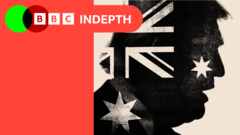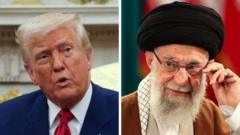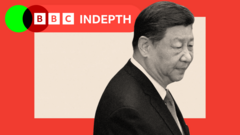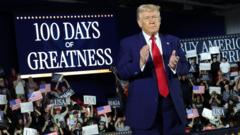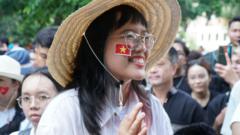A delicate balance between saving face and pursuing negotiations looms over the trade relations of the world's two largest economies.
**Who Will Blink First in the US-China Trade War?**
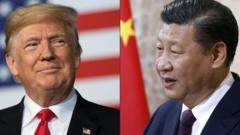
**Who Will Blink First in the US-China Trade War?**
Increased tariffs fuel a complex standoff between Trump and Xi as both leaders navigate domestic and international pressures.
As of Thursday, reports from Chinese state media revealed that the United States has been trying to engage in tariff negotiations with China, a development awaited by global observers amidst soaring tariffs, reaching as high as 245% on specific exports from China to the US. This escalating trade war raises serious concerns about a potential recession, leading President Donald Trump's administration to pursue multiple channels of communication with Beijing.
An anonymous statement posted on Weibo by Yuyuantantian, an account linked to China Central Television (CCTV), claimed that China sees no necessity to engage in talks with the United States. The post implied that the United States is the party under pressure to negotiate. This declaration came shortly after Trump remarked that discussions were ongoing, a statement that Beijing denied.
This ongoing exchange of claims and counterclaims suggests a stalemate, wherein the timing and conditions for negotiations remain uncertain, but the inevitability of talks seems destined. Analysts describe this scenario as akin to a high-stakes "game of chicken," with both Trump and Xi attempting to maintain their dignity while secretly seeking an agreement that alleviates the trade tensions.
Ja Ian Chong, an assistant professor at the National University of Singapore, stated, "Neither Washington nor Beijing wants to look like they are the side that's giving in." There is a strong mutual incentive for de-escalation, as both men attempt to position themselves as the strong leader in the eyes of their constituencies. Academic Wen-Ti Sung likens their interactions to colliding race cars, where the first to swerve is perceived as the weaker party.
Presently, neither Trump nor Xi appears willing to concede first. The narrative of strength shapes their negotiations; admitting to being the first to reach out could diminish their respective negotiating positions. The situation has resulted in a tactic known as "constructive ambiguity," where intentionally vague language allows each party to claim righteousness.
In the current context, a potential resolution could emerge from a third-party mediator or a broader interpretation of communication efforts—from either side—indicating an opening without revealing weakness. For both leaders, it’s critical to present any progress as a victory domestically.
The socio-economic landscape complicates these negotiations further. Trump is under pressure as recession fears grow, while Xi is managing a struggling economy with low consumption and employment issues. Both leaders recognize that they are unlikely to achieve maximal gains and instead may seek a compromise where they can each claim a partial victory.
As negotiations unfold, it is clear that both China and the US face economic repercussions from the trade standoff, heightening the urgency to reach a mutually acceptable resolution. However, despite acknowledging some level of dialogue, experts caution that the deeply rooted tensions will not evaporate easily.
Chong observes that while contacts between the two nations seem evident, the core challenges remain unaddressed, and predictions for swift resolutions are unwarranted. Each side is likely to maintain the standoff until one shows signs of capitulation, keeping the world wondering who will yield first.
An anonymous statement posted on Weibo by Yuyuantantian, an account linked to China Central Television (CCTV), claimed that China sees no necessity to engage in talks with the United States. The post implied that the United States is the party under pressure to negotiate. This declaration came shortly after Trump remarked that discussions were ongoing, a statement that Beijing denied.
This ongoing exchange of claims and counterclaims suggests a stalemate, wherein the timing and conditions for negotiations remain uncertain, but the inevitability of talks seems destined. Analysts describe this scenario as akin to a high-stakes "game of chicken," with both Trump and Xi attempting to maintain their dignity while secretly seeking an agreement that alleviates the trade tensions.
Ja Ian Chong, an assistant professor at the National University of Singapore, stated, "Neither Washington nor Beijing wants to look like they are the side that's giving in." There is a strong mutual incentive for de-escalation, as both men attempt to position themselves as the strong leader in the eyes of their constituencies. Academic Wen-Ti Sung likens their interactions to colliding race cars, where the first to swerve is perceived as the weaker party.
Presently, neither Trump nor Xi appears willing to concede first. The narrative of strength shapes their negotiations; admitting to being the first to reach out could diminish their respective negotiating positions. The situation has resulted in a tactic known as "constructive ambiguity," where intentionally vague language allows each party to claim righteousness.
In the current context, a potential resolution could emerge from a third-party mediator or a broader interpretation of communication efforts—from either side—indicating an opening without revealing weakness. For both leaders, it’s critical to present any progress as a victory domestically.
The socio-economic landscape complicates these negotiations further. Trump is under pressure as recession fears grow, while Xi is managing a struggling economy with low consumption and employment issues. Both leaders recognize that they are unlikely to achieve maximal gains and instead may seek a compromise where they can each claim a partial victory.
As negotiations unfold, it is clear that both China and the US face economic repercussions from the trade standoff, heightening the urgency to reach a mutually acceptable resolution. However, despite acknowledging some level of dialogue, experts caution that the deeply rooted tensions will not evaporate easily.
Chong observes that while contacts between the two nations seem evident, the core challenges remain unaddressed, and predictions for swift resolutions are unwarranted. Each side is likely to maintain the standoff until one shows signs of capitulation, keeping the world wondering who will yield first.



